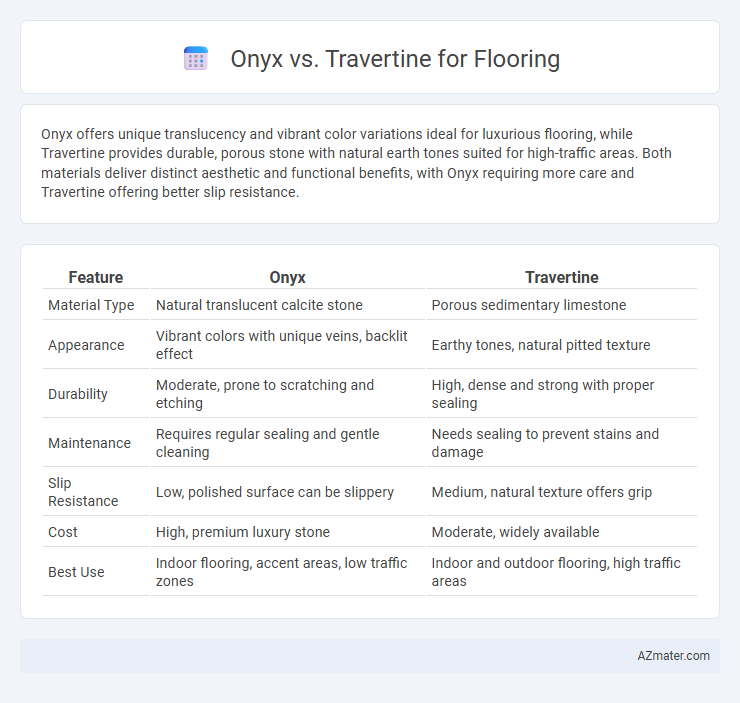Onyx offers unique translucency and vibrant color variations ideal for luxurious flooring, while Travertine provides durable, porous stone with natural earth tones suited for high-traffic areas. Both materials deliver distinct aesthetic and functional benefits, with Onyx requiring more care and Travertine offering better slip resistance.
Table of Comparison
| Feature | Onyx | Travertine |
|---|---|---|
| Material Type | Natural translucent calcite stone | Porous sedimentary limestone |
| Appearance | Vibrant colors with unique veins, backlit effect | Earthy tones, natural pitted texture |
| Durability | Moderate, prone to scratching and etching | High, dense and strong with proper sealing |
| Maintenance | Requires regular sealing and gentle cleaning | Needs sealing to prevent stains and damage |
| Slip Resistance | Low, polished surface can be slippery | Medium, natural texture offers grip |
| Cost | High, premium luxury stone | Moderate, widely available |
| Best Use | Indoor flooring, accent areas, low traffic zones | Indoor and outdoor flooring, high traffic areas |
Introduction to Onyx and Travertine Flooring
Onyx flooring is prized for its translucent properties, allowing light to pass through and create a luminous effect, making it a luxurious choice for high-end interiors. Travertine flooring, formed from natural limestone deposits, is known for its earthy tones and durable, porous surface, offering a rustic yet elegant appeal ideal for both indoor and outdoor spaces. Both materials provide unique aesthetic qualities and vary in maintenance, price, and installation complexity.
Key Aesthetic Differences Between Onyx and Travertine
Onyx flooring features a translucent, glass-like appearance with striking, vibrant veins and rich color variations that create a luxurious and dramatic effect. Travertine has a more muted, earthy texture with natural pits and holes that offer a rustic, warm appearance and a matte finish. The key aesthetic difference lies in onyx's polished brilliance and translucency versus travertine's natural, porous surface and subtle color palette.
Durability: Onyx vs Travertine for High-Traffic Areas
Onyx offers a striking appearance but has lower durability compared to travertine, making it less suitable for high-traffic areas due to its softer surface and susceptibility to scratches and etching. Travertine boasts enhanced toughness and resistance to wear, making it a preferred choice for flooring in commercial spaces and heavily trafficked residential areas. Its porous structure may require sealing, but its long-term durability supports sustained performance in demanding environments.
Cost Comparison: Onyx vs Travertine Flooring
Onyx flooring typically costs between $30 to $50 per square foot, making it a premium choice due to its rarity and translucency, while travertine averages $3 to $7 per square foot, offering a more budget-friendly option. Installation expenses for onyx are higher because of its delicate nature and specialized handling requirements compared to travertine, which is easier to cut and install. Long-term maintenance costs favor travertine, as onyx requires careful sealing and maintenance to prevent damage, increasing overall expenses over time.
Maintenance Requirements of Onyx and Travertine
Onyx flooring requires regular sealing and gentle cleaning with pH-neutral products to prevent etching and staining due to its softer, more porous nature. Travertine demands periodic sealing and routine sweeping to minimize dirt accumulation in its natural pits and grooves, while avoiding acidic cleaners to protect its calcium carbonate composition. Both stones benefit from immediate spill cleanup and moderate foot traffic to maintain their polished appearance and longevity.
Installation Process: What to Expect
Onyx flooring requires careful handling during installation due to its translucency and brittleness, often necessitating a skilled professional to prevent cracking. Travertine, a more porous and durable natural stone, allows for some flexibility in cutting and setting, but demands sealing to protect against stains. Both materials benefit from a substrate that is level and stable, with onyx installations typically involving backlighting considerations that add complexity to the process.
Environmental Impact and Sustainability
Onyx flooring, derived from sedimentary carbonate rock, requires significant energy for extraction and processing, resulting in a higher carbon footprint compared to travertine, a natural limestone known for its durability and lower environmental impact. Travertine's abundant availability and minimal chemical treatment make it a more sustainable choice for eco-conscious flooring projects. Both stones are recyclable, but travertine's lower quarrying disturbance and longer lifespan contribute to better overall environmental sustainability.
Best Interior Applications for Onyx Floors
Onyx flooring offers a luxurious and translucent appearance that enhances interior spaces such as living rooms, foyers, and bathrooms where natural light can highlight its unique veining and color variations. Its delicate nature makes it best suited for areas with low foot traffic or where protective finishes can preserve its surface. Compared to travertine, onyx provides a more dramatic, elegant aesthetic ideal for creating statement floors and decorative accents in upscale interior designs.
Ideal Spaces for Travertine Flooring
Travertine flooring is ideal for high-traffic areas such as kitchens, hallways, and living rooms due to its durability and natural slip resistance. Its porous surface and warm, earthy tones complement Mediterranean, rustic, and traditional interior designs, enhancing spaces like bathrooms and patios. Travertine is also suitable for both indoor and outdoor applications, making it versatile for various home environments.
Choosing the Right Stone: Final Recommendations
Onyx offers a stunning visual appeal with its translucent patterns but is softer and less durable compared to travertine, making it more suitable for low-traffic areas. Travertine, known for its natural texture and superior durability, is ideal for high-traffic spaces and outdoor flooring due to its resistance to wear and weathering. Choose travertine for longevity and practicality, while onyx suits elegant, decorative applications where aesthetic impact is prioritized over durability.

Infographic: Onyx vs Travertine for Flooring
 azmater.com
azmater.com